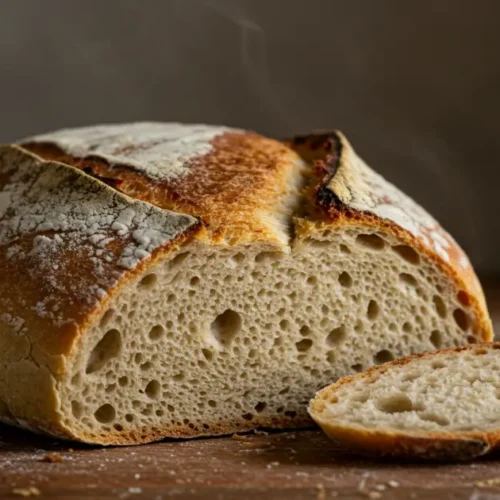Sheepherder bread is a rustic, homemade loaf with a golden crust and soft, fluffy interior. Traditionally baked by Basque sheepherders in Dutch ovens, it has a rich history and simple ingredients. This hearty bread is perfect for sandwiches, toasting, or serving with soups and stews.
Why We Love This Sheepherder Bread
Sheepherder bread is a classic homemade loaf with a beautifully crisp crust and a soft, airy interior. Its simple ingredients and no-fuss method make it perfect for both beginner and experienced bakers.
- Easy to make – Uses basic pantry staples with minimal hands-on time.
- Rustic and Flavorful – A traditional yeast bread with a slightly chewy texture and rich aroma.
- Versatile – Great for sandwiches, toast, or served alongside soups and stews.
- Timeless Tradition – Inspired by Basque sheepherders, this bread carries history in every bite.
Whether baked in a Dutch oven or a standard pan, this old-fashioned bread delivers a satisfying bakery-style experience straight from your kitchen.

Ingredients for sheepherder bread
Active dry yeast – Active dry yeast is essential for leavening the bread and giving it a light texture. Instant yeast can be used, but it may alter rising times.
Sugar – Sugar is important for activating the yeast and allowing proper fermentation. Although alternatives like honey can be used, sugar is preferred for its traditional effect.
Salt – Salt enhances the flavor and controls the yeast’s activity, ensuring the bread rises correctly without making it overly salty.
All-purpose flour – All-purpose flour provides structure and texture to the bread. While bread flour can be used, all-purpose flour is ideal for this simple recipe.
Instructions
Baking sheepherder bread is easy and satisfying, with just a few simple steps to follow. Let’s get started!
Activate the yeast: In a small bowl, combine the warm water and sugar. Stir gently, then sprinkle the yeast on top. Let it sit for about 5–10 minutes until it becomes foamy and bubbly.
Mix the dough: In a large bowl, combine the salt and flour. Pour the activated yeast mixture into the flour and stir with a wooden spoon until the dough comes together.
Knead the dough: Transfer the dough onto a floured surface and knead for about 8–10 minutes or until it’s smooth and elastic. You can also use a stand mixer with a dough hook for this step.
Let it rise: Place the dough in a lightly oiled bowl, cover it with a clean kitchen towel, and let it rise for 1–2 hours or until it has doubled in size.
Shape the dough: Punch down the dough to release any air bubbles, then shape it into a round loaf.
Second rise: Place the shaped dough on a parchment-lined baking sheet or into a greased Dutch oven. Cover and let it rise for another 30 minutes.
Preheat the oven: While the dough is rising, preheat your oven to 375°F (190°C).
Bake the bread: Once the dough has risen, bake it for 35–40 minutes or until the bread is golden brown and sounds hollow when tapped on the bottom.
Cool and serve: Let the bread cool on a wire rack for at least 20 minutes before slicing and serving. Enjoy!
This rustic bread pairs wonderfully with a warm bowl of soup or as a base for your favorite sandwich.
Pro Tips
To help you bake the perfect sheepherder bread, here are some handy tips that will ensure your loaf turns out soft, golden, and delicious:
Use warm water – It should be around 110°F (43°C). Too hot, and it can kill the yeast; too cold, and it won’t activate properly.
Knead thoroughly – The more you knead, the smoother and stretchier your dough will become. Don’t rush this step; aim for 8–10 minutes of kneading to develop the right texture.
Check your flour – If your dough feels too sticky, you can add a bit more all-purpose flour until it reaches a smooth consistency. But be cautious, as too much flour can make the bread dense.
Give it time to rise – Don’t be tempted to rush the rising process. Let the dough double in size during the first rise, and the second rise will help develop a lighter texture.
Use a Dutch oven – For an extra crispy crust, consider baking the bread in a preheated Dutch oven. This mimics the traditional method used by sheepherders, creating a beautifully browned, rustic crust.
Tap for doneness – To test if your bread is fully baked, tap the bottom of the loaf. If it sounds hollow, it’s ready to come out of the oven.
With these tips, your rustic bread will have the perfect balance of soft texture and crisp crust, just like the classic artisan loaves baked by Basque sheepherders!
Variations
While sheepherder bread is perfect as is, there are plenty of ways to make it your own! Try these variations to add your personal touch to this classic loaf:
Herbed sheepherder bread: Add 2 tablespoons of dried rosemary, thyme, or oregano to the dough for an aromatic twist. Fresh herbs also work well if you have them on hand!
Cheesy sheepherder bread: Mix 1 cup of shredded cheddar cheese or parmesan into the dough before the first rise for a cheesy, savory flavor. You can even sprinkle some on top before baking.
Garlic Bread Variation: Add 4 minced garlic cloves to the dough for a rich, garlicky flavor. If you love garlic bread, this variation will be your new favorite!
Whole Wheat sheepherder bread: Swap half of the all-purpose flour for whole wheat flour to create a more rustic, nutty version of the bread. It’s a great option for those looking for extra fiber.
Serving Suggestions for Sheepherder Bread
Once your sheepherder bread has cooled, it’s ready to be enjoyed in a variety of delicious ways. Here are some simple serving ideas to complement this rustic, homemade loaf:
Soup Companion: Serve with a warm bowl of tomato soup, beef stew, or vegetable soup. The bread’s crusty exterior and soft interior make it perfect for dipping!
Sandwich Base: Slice the bread thick and use it as the base for hearty sandwiches. Think roast beef, turkey, or a classic ham and cheese – the possibilities are endless.
Garlic Bread: For a flavorful twist, brush slices of sheepherder bread with butter, garlic, and parsley, then toast it in the oven for a crispy, garlicky side dish.
Breakfast Treat: Toast a slice and top it with butter, jam, or cream cheese for a satisfying breakfast or snack. For a sweet touch, try drizzling a bit of honey over the warm bread.
Cheese Pairing: The hearty flavor of this bread pairs wonderfully with a variety of cheeses. Try it with cheddar, brie, or even a bit of goat cheese for an elevated snack or appetizer.
More Bread recipes you will love!
FAQs about sheepherder bread
What is sheepherder bread?
Sheepherder bread is a traditional, rustic artisan bread that originates from the Basque sheepherders who would bake it in large, round loaves. It’s made with simple ingredients like flour, yeast, salt, and water, but its texture and flavor are truly unique. The bread has a crispy crust, soft inside, and a slightly chewy texture that makes it perfect for dipping, toasting, or serving alongside meals.
What is the history of sheepherder bread?
This bread has roots in the Basque culture, created by sheepherders who needed a durable bread to sustain them during long trips in the mountains. It was traditionally baked in large, round shapes and could last for days without spoiling. Over time, it became a staple in Basque communities and is now enjoyed by bread lovers around the world for its rich history and delicious flavor.
Can I make Sheepherder Bread without a Dutch oven?
Absolutely! While a Dutch oven gives the bread a beautiful crust, you can still make sheepherder bread by baking it on a baking sheet. Just make sure to preheat the oven and place a pan of water on the lower rack to create steam. This will help you achieve a crispy crust even without a Dutch oven.

sheepherder bread
Ingredients
- 2 ½ cups warm water 110°F
- 2 ¼ teaspoons active dry yeast 1 packet
- ¼ cup sugar
- 1 ½ teaspoons salt
- 6 cups all-purpose flour
Instructions
- Activate the yeast – Mix warm water and sugar in a small bowl, then sprinkle the yeast on top. Let it sit for 5–10 minutes until foamy.
- Mix the dough – In a large bowl, combine flour and salt. Add the yeast mixture and stir until the dough comes together.
- Knead the dough – Transfer the dough to a floured surface and knead for 8–10 minutes until smooth and elastic.
- Let it rise – Place the dough in an oiled bowl, cover with a towel, and let it rise for 1–2 hours until doubled in size.
- Shape the dough – Punch down the dough, then shape it into a round loaf.
- Second rise – Place the dough on a parchment-lined baking sheet or in a greased Dutch oven. Let it rise for 30 minutes.
- Preheat the oven – Preheat the oven to 375°F (190°C) while the dough rises.
- Bake the bread – Bake the dough for 35–40 minutes or until golden brown and sounds hollow when tapped.
- Cool and serve – Let the bread cool for 20 minutes before slicing and serving. Enjoy!
Send me this recipe!
Just enter your email below and get it sent straight to your inbox!


